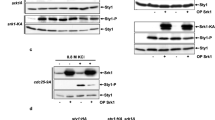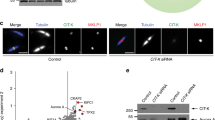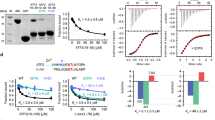Abstract
Mitogen-activated protein kinases (MAPKs) are evolutionarily conserved enzymes that convert extracellular signals into various outputs such as cell growth, differentiation and cell death1,2,3,4. MAPK phosphatases selectively inactivate MAPKs by dephosphorylating critical phosphothreonine and phosphotyrosine residues5,6. The transcriptional induction of MAPK phosphatase expression by various stimuli, including MAPK activation, has been well documented as a negative-feedback mechanism of MAPK signalling7,8. Here we show that Rnc1, a novel K-homology-type RNA-binding protein in fission yeast, binds and stabilizes Pmp1 messenger RNA9, the MAPK phosphatase for Pmk1 (refs 10, 11). Rnc1 therefore acts as a negative regulator of Pmk1 signalling. Notably, Pmk1 phosphorylates Rnc1, causing enhancement of the RNA-binding activity of Rnc1. Thus, Rnc1 is a component of a new negative-feedback loop that regulates the Pmk1 pathway through its binding to Pmp1 mRNA. Our findings—the post-transcriptional mRNA stabilization of a MAPK phosphatase mediated by an RNA-binding protein—provide an additional regulatory mechanism for fine-tuning of MAPK signalling pathways.
This is a preview of subscription content, access via your institution
Access options
Subscribe to this journal
Receive 51 print issues and online access
$199.00 per year
only $3.90 per issue
Buy this article
- Purchase on Springer Link
- Instant access to full article PDF
Prices may be subject to local taxes which are calculated during checkout




Similar content being viewed by others
References
Herskowitz, I. MAP kinase pathways in yeast: for mating and more. Cell 80, 187–197 (1995)
Marshall, C. J. MAP kinase kinase kinase, MAP kinase kinase and MAP kinase. Curr. Opin. Genet. Dev. 4, 82–89 (1994)
Nishida, E. & Gotoh, Y. The MAP kinase cascade is essential for diverse signal transduction pathways. Trends Biochem. Sci. 18, 128–131 (1993)
Levin, D. E. & Errede, B. The proliferation of MAP kinase signaling pathways in yeast. Curr. Opin. Cell Biol. 7, 197–202 (1995)
Camps, M., Nichols, A. & Arkinstall, S. Dual specificity phosphatases: a gene family for control of MAP kinase function. FASEB J. 14, 6–16 (2000)
Keyse, S. M. Protein phosphatases and the regulation of mitogen-activated protein kinase signalling. Curr. Opin. Cell Biol. 12, 186–192 (2000)
Sun, H., Charles, C. H., Lau, L. F. & Tonks, N. K. MKP-1 (3CH134), an immediate early gene product, is a dual specificity phosphatase that dephosphorylates MAP kinase in vivo. Cell 75, 487–493 (1993)
Keyse, S. M. & Emslie, E. A. Oxidative stress and heat shock induce a human gene encoding a protein-tyrosine phosphatase. Nature 359, 644–647 (1992)
Sugiura, R., Toda, T., Shuntoh, H., Yanagida, M. & Kuno, T. pmp1+, a suppressor of calcineurin deficiency, encodes a novel MAP kinase phosphatase in fission yeast. EMBO J. 17, 140–148 (1998)
Toda, T. et al. The fission yeast pmk1+ gene encodes a novel mitogen-activated protein kinase homolog which regulates cell integrity and functions coordinately with the protein kinase C pathway. Mol. Cell. Biol. 16, 6752–6764 (1996)
Zaitsevskaya-Carter, T. & Cooper, J. A. Spm1, a stress-activated MAP kinase that regulates morphogenesis in S. pombe. EMBO J. 16, 1318–1331 (1997)
Yoshida, T., Toda, T. & Yanagida, M. A calcineurin-like gene ppb1+ in fission yeast: mutant defects in cytokinesis, cell polarity, mating and spindle pole body positioning. J. Cell Sci. 107, 1725–1735 (1994)
Sugiura, R., Toda, T., Dhut, S., Shuntoh, H. & Kuno, T. The MAPK kinase Pek1 acts as a phosphorylation-dependent molecular switch. Nature 399, 479–483 (1999)
Siomi, H., Matunis, M. J., Michael, W. M. & Dreyfuss, G. The pre-mRNA binding K protein contains a novel evolutionarily conserved motif. Nucleic Acids Res. 21, 1193–1198 (1993)
Burd, C. G. & Dreyfuss, G. Conserved structures and diversity of functions of RNA-binding proteins. Science 265, 615–621 (1994)
Ostareck-Lederer, A., Ostareck, D. H. & Hentze, M. W. Cytoplasmic regulatory functions of the KH-domain proteins hnRNPs K and E1/E2. Trends Biochem. Sci. 23, 409–411 (1998)
Loewith, R., Hubberstey, A. & Young, D. Skh1, the MEK component of the Mkh1 signaling pathway in Schizosaccharomyces pombe. J. Cell Sci. 113, 153–160 (2000)
Maundrell, K. Thiamine-repressible expression vectors pREP and pRIP for fission yeast. Gene 123, 127–130 (1993)
Lewis, H. A. et al. Sequence-specific RNA binding by a Nova KH domain: implications for paraneoplastic disease and the fragile X syndrome. Cell 100, 323–332 (2000)
Buckanovich, R. J. & Darnell, R. B. The neuronal RNA binding protein Nova-1 recognizes specific RNA targets in vitro and in vivo. Mol. Cell. Biol. 17, 3194–3201 (1997)
Davis, R. J. The mitogen-activated protein kinase signal transduction pathway. J. Biol. Chem. 268, 14553–14556 (1993)
Rothstein, R. J. One-step gene disruption in yeast. Methods Enzymol. 101, 202–211 (1983)
Kohrer, K. & Domdey, H. Splicing and spliceosome formation of the yeast MATa1 transcript require a minimum distance from the 5′ splice site to the internal branch acceptor site. Nucleic Acids Res. 6, 9457–9475 (1988)
Rodriguez, P. L. & Carrasco, L. Nonradioactive northwestern analysis using biotinylated riboprobes. Biotechniques 17, 702–707 (1994)
Acknowledgements
We thank M. Yanagida and T. Toda for their gift of strains and plasmids, S. Nakielny and M. Sakaue for discussions, and M. Takeuchi for technical assistance. This work was supported in part by research grants from the Ministry of Education, Culture, Sports, Science and Technology of Japan.
Author information
Authors and Affiliations
Corresponding author
Ethics declarations
Competing interests
The authors declare that they have no competing financial interests.
Supplementary information
Rights and permissions
About this article
Cite this article
Sugiura, R., Kita, A., Shimizu, Y. et al. Feedback regulation of MAPK signalling by an RNA-binding protein. Nature 424, 961–965 (2003). https://doi.org/10.1038/nature01907
Received:
Accepted:
Issue Date:
DOI: https://doi.org/10.1038/nature01907
This article is cited by
-
RNA-binding protein IMP3 is a novel regulator of MEK1/ERK signaling pathway in the progression of colorectal Cancer through the stabilization of MEKK1 mRNA
Journal of Experimental & Clinical Cancer Research (2021)
-
Rae1-mediated nuclear export of Rnc1 is an important determinant in controlling MAPK signaling
Current Genetics (2018)
-
Cytoplasmatic post-transcriptional regulation and intracellular signalling
Molecular Genetics and Genomics (2007)
-
Negative regulation of ERK activity by VRK3-mediated activation of VHR phosphatase
Nature Cell Biology (2006)
-
Dysregulation of growth factor signaling in human hepatocellular carcinoma
Oncogene (2006)
Comments
By submitting a comment you agree to abide by our Terms and Community Guidelines. If you find something abusive or that does not comply with our terms or guidelines please flag it as inappropriate.



